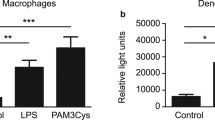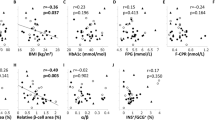Abstract
Previously, transgenic mice were constructed overexpressing human insulin-like growth factor II (IGF-II) under control of the H2kb promoter. The IGF-II transgene was highly expressed in thymus and spleen, and these organs showed an increase in weight. In the current study we have analyzed the sites of IGF-II mRNA expression, the distribution of IGF-II, IGF-I, and both IGF receptors, and histomorphometrical changes in thymus and spleen. With in situ mRNA hybridization, expression of the IGF-II transgene is found with high intensity in the thymic medulla and in the white pulp/marginal zone of the spleen, whereas there were scattered positive cells in the thymic cortex and in the splenic red pulp. Hybridization was restricted to non-lymphocytic cells. Immunohistochemistry revealed intense IGF-II peptide staining with the same distribution as IGF-II mRNA. There was additional intense IGF-II staining of all elements in the splenic red pulp (including trabeculae) and diffuse, low level staining in the thymic cortex. These findings were not observed in control mice. In the thymic medulla, most IGF-II producing cells co-labelled with keratin, whereas a minor population also stained for the monocyte/macrophage marker MOMA-2. In the spleen, co-labelling of IGF-II producing cells was found with MOMA-1 (marginal zone), or with the dendritic cell marker NLDC-145 (red pulp). IGF-I and both IGF receptors were found in these organs in nearly all cell types, with a similar pattern in transgenic mice and in control animals. Histomorphometric analysis revealed a marked increase of thymus cortex size and an increased trabecular size in the spleen. This suggests that IGF-II overproduction induces local effects (auto/paracrine) in the thymic cortex, but not in the thymic medulla. Trabecular growth in the spleen most likely is a distant effect (paracrine or endocrine) of IGF-II overproduction.
Similar content being viewed by others
Author information
Authors and Affiliations
Additional information
Accepted: 5 September 1996
Rights and permissions
About this article
Cite this article
Van der Ven, L., Roholl, P., Reijnen-Gresnigt, M. et al. Expression of insulin-like growth factor II (IGF-II) and histological changes in the thymus and spleen of transgenic mice overexpressing IGF-II. Histochemistry 107, 193–203 (1997). https://doi.org/10.1007/s004180050104
Issue Date:
DOI: https://doi.org/10.1007/s004180050104




